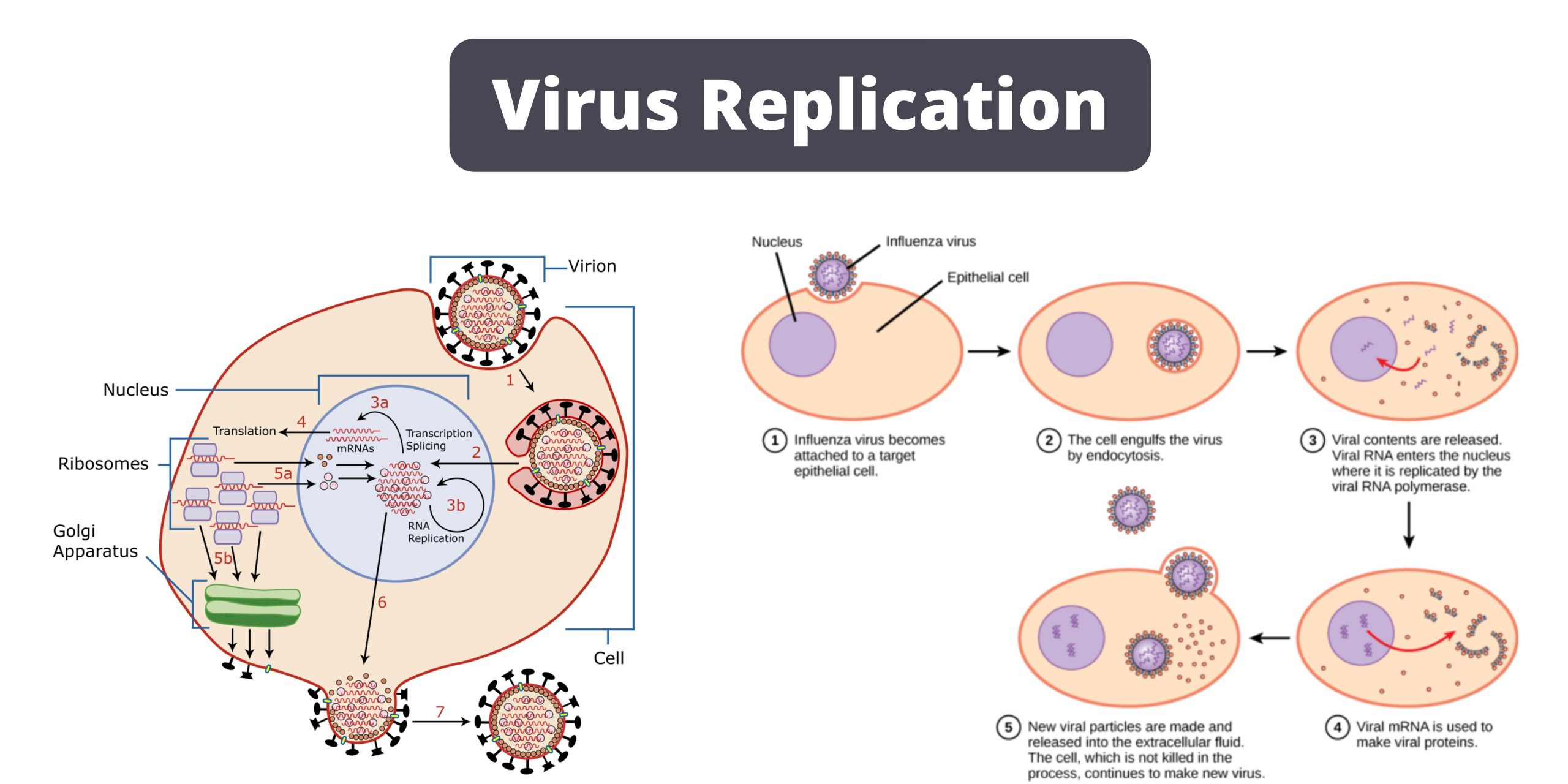A white blood cell. To initiate infection the virus must be able to bind to target cell.

Viral Replication Cycle Definition Steps Mechanisms
Replication Overview Upon entering the host cell the virus must accomplish two basic tasks.

. Binding is highly specific. But within a host cell a virus can commandeer cellular machinery to produce more viral particles. These proteins are the components of daughter virion capsids.
Adsorption - virus binds to the host cell. Instead of packaging viral DNA it takes a random piece of host DNA and inserts it into the capsid. Assembly and Release Sixth and Seventh Steps Process involves bringing together newly formed genomic nucleic acid and structural proteins to form the nucleocapsid of the virus Nonenveloped viruses exhibit full maturation in the cytoplasm or nucleus with disintegration of cell Steps in Viral Replication.
Replication of viral nucleic acid. The virus first attaches to the host cell by binding to specific surface proteins. The disintegration or destruction of cells.
Using the hosts cell machinery the viral genetic material is replicated viral proteins are formed. During the lytic cycle of viral replication the virus hijacks the host cell degrades the host chromosome and makes more viral genomes. Virus dendritic cell interaction.
The virion RNA is converted to a double-stranded DNA form by the virion RT which uses a proline tRNA primer and carries a. The shell of the capsid disintegrates and the HIV protein called reverse transcriptase transcribes the viral RNA into DNA. Penetration of virus into host cell.
By themselves viruses do not encode for all of the enzymes necessary for viral replication. Adsorption penetration replication assembly maturation release. Steps of Virus Replication Cycle Binding occurs between.
Attachment of virus to outer surface of suitable host cell. Delivery of virus to lymph nodes. Replication of the viral genome and synthesis of viral structural proteins.
Describe the replication process of plant viruses. Viral proteins on the capsid or phospholipid envelope interact with specific receptors on the host cellular surface. Through the generation of abundant copies of its genome and packaging these copies the virus continues infecting new hosts.
Instead they use the machinery and metabolism of a host cell to produce new copies of themselves. In this process the viral genome is multiplied for the synthesis of new Virions. This involves the viral capsid degrading either by the action of viral or host enzymes.
147148 Viral translation occurs in association with the rough ER by the process of internal ribosome entry and the polyprotein undergoes a series of further cotranslational proteolytic cleavages as. Entry -- The virus. This process is known as uncoating and allows the viral genome to directly access the host cells molecular machinery.
All viruses depend on cells for reproduction and metabolic processes. A process in which the viral capsid of a virus is removed leading to the release of the viral genomic nucleic acid. Explain the process of transduction.
After infecting a host cell a virion uses the cells ribosomes enzymes ATP and other components to replicate. Viral genome replication ie. The viral RNA is released into the cytoplasm where it acts as messenger RNA directing the cap-independent translation of the viral polyprotein.
Viruses must first get into the cell before viral replication can occur. Although the specific detail of virus replication vary from one virus to another general replication is same for most virus. Steps in Viral Replication.
The process of attachment to a specific receptor can induce conformational changes in viral capsid proteins or. This enables the start. Penetration - virus injects its genome into host cell.
A capsid containing the viruss genome and proteins then enters the cell. Virus replication proceeds following binding to specific host cell-surface receptors internalization and uncoating. The synthesis of a full-length positive-sense copy of the genome and the subsequent generation of progeny negative-strands is catalyzed by the same polymerase that directs transcription.
There are seven steps to viral replication and they can be divided as follows. As it assembles and packages DNA into the phage head packaging occasionally makes a mistake. Release A mnemonic to remember the stages of virus replication is the sentence A PUR ple A pple M ight R edden.
HIV Replication Cycle. The viral genetic material is then injected into the host cell. Viral Genome Replication - viral genome replicates using the hosts cellular machinery.
The seven stages of virus replication are categorized as follows. A process called Adsorption. Transcription of mRNA Late Transcription and then the formation of proteins called as late or structural proteins Late Translation.
Specific binding between viral. Infection is typically with R5 M-tropic strains. The SIX steps of viral replication are.
The basic process of viral infection and virus replication occurs in 6 main steps. Virus taken into cell by endocytosis or viral envelope fuses with host cell membrane and dumps content into host cell Replication Viral genes are copied. Assembly - viral components and enzymes are produced and begin to assemble.
Viral replication is the formation of biological viruses during the infection process in the target host cells. This releases the genomic information mostly in RNA form but can be in DNA form. This infographic illustrates the HIV replication cycle which begins when HIV fuses with the surface of the host cell.
- Ligands on the virus surface viral attachment proteins - Receptors on cell membrane 1 Attachment To initiate replication infection the virus must be able to bind to target cell. Attachment -- The proteins on the virus shell attach to specific receptors on the host cell. Replication of Viruses Populations of viruses do not grow through cell division because they are not cells.

The Viral Life Cycle Microbiology

Viral Replication Boundless Microbiology
0 Comments